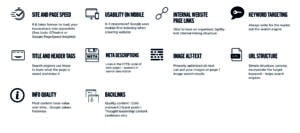Our 4-step guide to building a better Google ranking
89% of B2B buyers use Google to find products, services and businesses. When prospects begin searching for businesses for their next construction project, you want yours to be top of the pile. This is why search engine optimisation (SEO) is critical for making connections and growing your new business pipeline. A bit of admin at the business end of your site will help it rank higher than your competitors in search results – driving more website traffic and an increase in quality sales or leads.
So, how can you do this to skill your ambitions? By building and nurturing an organic SEO strategy into your company’s marketing plans.
STEP 1: UNDERSTAND HOW GOOGLE’S RANKING SYSTEM WORKS
Google, and other search engines like Bing, are constantly evolving to index thousands of web pages in seconds to direct visitors to the right website for their search.
These are your potential customers. You want them to click on your website first.
BUT… search engine algorithms change and there’s SO much data to get your head around. Not so. Of the 200+ factors that go into search rankings, you only need to focus on three:
1) RELEVANCE to your customer’s search
2) QUALITY of your content
3) And the REPUTATION of your website
A comprehensive SEO strategy will help you do this, by giving your website the edge over your competitors by ranking higher on Google.

STEP 2: PREPARE TO OPTIMISE YOUR WEBSITE
To optimise your website and create relevant, quality content, you need to know what your prospects are searching for – so that you can finetune your site and its content to deliver the answer.
I recommend starting with…
Keyword research
Keywords can be one individual word to longer phrases, called long tail keywords.
Successful SEO hinges on choosing and using the most appropriate keywords used to search for your specific products, services and location.
There are plenty of sites and tools out there to help, many of which are free. You can’t beat going direct to source, so try Google’s Keyword Planner first.
Done your keyword research? You’re ready for…
Keyword optimisation
Your research will help you determine the most commonly searched for words and phrases for your business. These words and phrases will need building into both the technical parts of the website and the content you create.
Proper use of these keywords will help drive traffic to your website by attracting the attention of search engines at the moment your prospects need you. By proper, I mean natural and relevant. Not forced lists or endless repetitions.
STEP 3: GROUNDWORK ON YOUR SEO STRATEGY
A good way to formulate your strategy, is with an understanding of these five basic SEO principles.
1. SAY WHAT THEY’LL SEE
Use direct headlines and titles that clearly describe what your site’s content is about. Say what your prospects will see in a way that syncs seamlessly with what they’re searching for in the first place – using the right keywords from step 2.
This will help lead them directly to your products or services IF they match up the initial search. This is why relevance is, well, so relevant.
2. LABEL YOUR IMAGES
Clearly label image files to describe what’s in the picture, to help the search engines understand. Sometimes your customers will want to see what you sell or supply, so don’t rely on a named file like ‘IMG262.pipe’ to tell Google exactly what’s in the picture.
It’s easier to rank highly on the image search page than it is on the main Google search results page. So if you sell products, label the images for another way to be found.
So many websites skip this SEO principle. Their loss.
3. HELP THE SPIDERS
Make sure your website is user-friendly, loads quickly, works on mobile and has a site-map (so search ‘spiders’ know how to navigate it). If your site is s-l-o-w to load, Google knows your prospects won’t stick around. That’s bad for business.
4. GET ON THE BUSINESS HIT LIST
List your website and business on Google My Business with your opening hours, address, pictures and reviews. It might sound simple, but so many businesses forget to start local.
And last but definitely not least…
5. STAND OUT FROM THE CROWD
• Website content can grow dated and lose value over time – Google values freshness (see our hints and tips for creating great blog content)
• Keep up to date with what your potential customers are looking for, trends emerge and change all the time in construction
• Create content that solves their problem and give all prospects a good online experience; whether that’s in the form of a landing page, video, app, article, infographic, product, service or any other ideas you come up with
• Make sure your website solves your prospective customer’s biggest problem or challenge
STEP 4: REALISE THE POWER OF FREE
Why pay for clicks when you can generate them for free, simply by optimising your current website?
9 times out of 10 users click organic results over paid ads
SEO has 20x more traffic opportunity than PPC on both mobile and desktop
Only 6% of people click on paid ads
I’ve just scratched the surface of Search, but hopefully inspired you to generate leads and grow your new business pipeline, with help from Barbour ABI.
